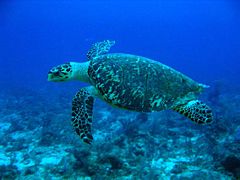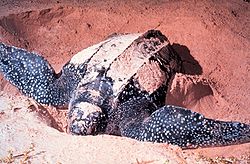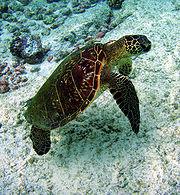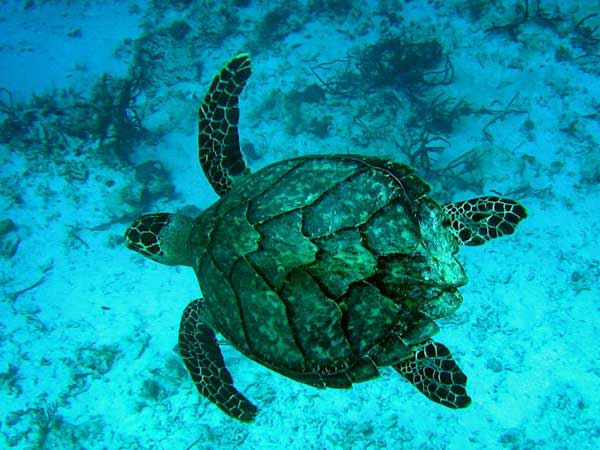Tag Archives: sea turtle
Attempts to Move Se Turtle Eggs Out of Gulf Oil Spill Proving Fruitful
We have all heard of the BP oil spill fiasco in the Gulf of Mexico. As the black goo made its way to the beaches of Alabama and Florida officials of those states began an effort to attempt to save the batch of sea turtles.
Their plan was to dig up thousands of the turtle eggs and then move them over to the Kennedy Space Center, so that they could be born in an oil free environment. As we know, not many sea turtles actually make it in the wild, they didn’t need the extra obstacle of coming into the world in an oil slick.
If even a few of these turtles survived, officials commented, it would be considered a grand success.
Based on the first raw data coming in, “it’s been more of a success than we thought it would be,” a spokesman for the US Fish and Wildlife Service, Chuck Underwood, commented this past Friday.
Of the thousands – somewhere over 25,000 – of eggs moved, 14,676 were hatched successfully and were then let go in the Atlantic Ocean. This means that over half of the turtle eggs which were moved actually hatched, and nearly 6 out of every 10 turtles made it into the black goo free water.
“We do feel it was a success that we got that number of hatchlings into the sea,” commented a spokeswoman for the Florida Fish and Wildlife Conservation Commission, Patricia Behnke. “Of course, what happens to them after that, we don’t know. But we never do.”
Two-Headed Turtle in Phuket Needs Name
Well, this is certainly interesting news. It appears that a two-headed turtle (Picture gallery) has gripped the attention of Phuket, and may turn into a full blow two-headed turtle mania if the media coverage is any indication.
The Royal Thai Navy has created a contest to help come up with a suitable name for the 18-day old turtle, which really created a stir when it was put on display in the turtle sanctuary at the Navy base in Tablamu, just to the north of Phuket.
Chatjen Choipean, a warrant officer who is in charge of many functions at the Navy hatchery beach at Hu Young Island in the Similans has commented that the two-headed turtle was the last in a batch of 26 turtles to hatch from the laying of 96 eggs. Turtles often lay there eggs on the beach between November and February.
This Olive Ridley turtle, officials are keeping their fingers crossed, may just do the same thing for Phuket and other turtles that a young panda has done for the Chinang Mai Zoo.
Last year, Warrant officer Chatjen explained, there were 80 separate nests made and eggs laid on the island. However, so far this year, there have only been 30.
”The young two-headed turtle is very strong and doing well,” he commented. This is the first time that a two-headed turtle has made an appearance in the Navy region, and many hope that it is a sign of good luck for the breeding attempts in the future, especially on the mainland and Phuket.
Visitors are encouraged to view the turtle at Tablamu, where they can also take advantage of one of the best golf courses in the area, and engage in one of many of the activities available in the surrounding Phang Nga countryside.
It is not known whether the two-headed turtle is male or female, and it could take up to 5 years to discover which it is, however, this will have no bearing on the decision of a name.
Rare “Princess” Turtle Makes Way Home After 32 Years
Well, they say turtles are slow, but this particular beauty made a surprise comeback to a Malaysian beach after an astonishing 32 years. A report issued Friday hailed this return as a “miracle” by conservationists and rekindling hope that the endangered species is not quite gone yet.
The leatherbacks, the biggest of all the sea turtle species, were at one time the stars of the show at Rantau Abang beach in the northern state of Terengganu. However, overfishing, poaching, and pollution have caused the population of these turtles to take a nose dive over the years, to the point of being critically endangered.
This turtle, aptly named “Puteri Rantau Abang” or Rantau Abang Princess, and identified by some special markings, had returned last month to finally end the long period of time that turtle sightings were rare, which began in Terengganu in the 1980’s.
“It is a miracle that leatherback turtles are making a comeback to this area,” commented, Ahamad Sabki Mahmood, the Malaysian Fisheries Department director-general.
He went on to explain that the return of this turtle proves that Rantau Abang is once again being made a nesting ground for turtles, he is hoping that the next possible nesting period between the 15th of August and 20th of August that more turtles will make an appearance.
This just goes to show you that old habits die hard, and that mother nature triumphs over all. Hopefully the future turtles which land at the beach will receive as warm a welcome.
More Than 30 Dead Sea Turtles Found in Guatamala
More than 30 sea turtles have washed up in Guatamala’s southern coast, dead, mutilated and showing signs of suffocation, authorities have reported.
The National Council of Protected areas has said that the turtles were discovered on the beaches of Sipacate and Monterrico.
Upon closer examination the turtles appeared to have succumbed to suffocation after having been trapped in fishing nets, the organization went on to explain, they added that the fishermen responsible were using fish hooks in zones labeled as being “off limits”.
According to the law of Guatamala, fishing nets are supposed to have a turtle excluder device (TED), which will allow any turtles trapped by accident to escape quickly, easily and unharmed.
The reason that this is most troubling is due to the fact that the nesting season has just gotten underway, and there are already efforts in place to protect these magnificent turtles which are already threatened. This statement comes from the head of the organization’s hydro-biological reources department, Jose Martinez.
There are six different kinds of sea turtle which nest in Guatamala, all of them are in danger of becoming extinct, due to human activities such as poaching, over harvesting of the eggs, and of course, pollution.
There are going to be further steps taken to help the protect the turtles, but it’s a big ocean, and there aren’t enough resources to provide for 24 hour surveillance of every nook and cranny.
Timer saves turtles?
A Cape Cod company is now launching a timer that might help save dwindling populations of sea turtles from being decimated by fishing nets.
The new device is a 7-inch (18 cm) long silver cylinder capable of keeping track of how long a net has been submerged. Federal research indicates that a vast majority of entangled sea turtles will survive if they are rescued and given a chance to breath within 50 minutes.
Green sea turtle –Chelonia mydas : Picture by Mila Zinkova
As soon as the device reaches a depth of at least two metres, it will start recording water depth every 30 seconds and it will also make note of any time-limit breaches. Since the honour system might not be enough, the timer has been built to save its data for later download by marine authorities.
Fishermen using the timer will not only help save the sea turtles; they may also be able to save themselves from more onerous regulations, such as no-fishing zones. The timer is naturally not a one-size fits all fix-all to the problem with turtles being drowned in fishing nets, but it might prove useful for certain types of nets in certain conditions.
The logger was built under a $25,000 federal contract with the National Oceanic and Atmospheric Administration by Onset Computer Corp., a Bourne-based supplier of data loggers for energy and environmental monitoring.
Hawksbill turtle released back into the wild after eight months of rehabilitation
The juvenile Hawksbill turtle found near-dead 8 months ago with a plastic shopping bag lodged inside her belly has made a remarkable recovery and has now been released back into the ocean. The Hawksbill turtle is listed as Critically Endangered on the IUCN Red List of ThreatenSped ecies, so each specimen that can be rescued is important for the population.
Eight months ago the young female, who has been dubbed Alva by her caregivers, was found halfway up the beach, upside down, with her head buried in the sand, slowly dying in the sun. She was rushed to Townsville’s Reef HQ turtle hospital where x-rays revealed that a large piece of plastic stuck inside her had caused a severe gut blockage.
In addition to receiving treatment for the blockage, Alva was bathed, scrubbed and hand-fed by the turtle hospital staff who gradually nursed her back to life from the near-death experience.
“We brought it back from brink of death”, said Reef HQ aquarium acting director Fred Nucifora. “That is the miracle.”
On May 21, Alva was deemed healthy enough to return to the sea and was released into the water in the Australian Great Barrier Reef Region.
“It was emotional to say goodbye,” said Nucifora. “We’d like to think Alva turned back and gave us a heartfelt look, but it was barely a glance and, with a flick of the flipper, she was off.”
Mexico requests Emergency Rule to Protect Sea Turtles
After a request from the Mexico Fishery Management Council, NOAA’s* Fisheries Service announced an emergency rule to protect the threatened sea turtles living in the Gulf of Mexico.
The emergency rule, which was announced on April 30, will take effect on May 18. From May 18 and onwards, the commercial reef fish longline fleet active in these waters will only be allowed to fish seaward of a line approximating the 50-fathom contour in the Gulf of Mexico. (Current regulations allow the fleet to fish as close as the 20-fathoms line.)
The emergency rule will also outlaw all reef fish longline fishing east of 85 degrees 30 minutes west longitude in the Gulf of Mexico after the quotas for deep water grouper and tilefish are reached.
The Mexico Fishery Management Council requested the emergency rule after a NOAA observer study documented how the reef fish longline fleet was incidentally catching and killing a substantial amount of loggerhead sea turtles, a species listed as “threatened” under the Endangered Species Act.
The emergency rule will be in effect for 180 days, but can be extended for up to an additional 186 days if necessary. The new rule will primarily affect those who fish for shallow-water grouper species, such as the popular food fish red grouper, since this type of fishing typically takes place in shallow waters within the 50-fathom contour off the west Florida shelf. Fishermen and groupers are however not the only ones occupying this area – it is also a very important feeding ground for sea turtles and therefore the place where most of the incidental sea turtle by-catches take place.
“We are working closely with the council and constituents to find more permanent solutions to protect sea turtles affected by this fishing gear,” said Roy Crabtree, NOAA’s Fisheries Service southeast regional administrator. “I hope we can identify options that not only provide sea turtles the protection they need, but minimize the economic affects to the fishing industry.”
The Gulf of Mexico Fishery Management Council is also considering actions to address the problem on a long-term basis.
The emergency rule is implemented in accordance with both the Endangered Species Act and the Magnuson-Stevens Act. The Magnuson-Stevens Act requires that conservation and management measures minimize bycatch of non-target species and minimize mortality when bycatch cannot be avoided.
* National Oceanic and Atmospheric Administration (NOAA)





